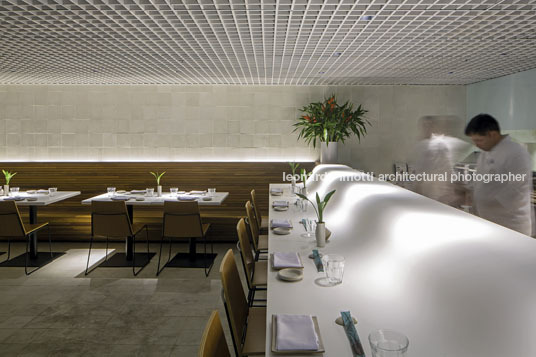gurumê fashion mall rio de janeiro rj, brazil
- tech chart
- Local: Rio de Janeiro, RJ Project date: 2014 Area 150 m² Architecture: Bernardes Arquitetura Interiors: Bernardes Arquitetura Team: Thiago Bernardes, Camila Tariki, Francisco Abreu, Daniel Vannucchi, Antonia Bernardes, Caroline Premoli, Victor Campos, Suzana Duarte, Luiza Landim Lighting: Studio Iluz Prêmios: - I Prêmio ASBEA/RJ, Menção Honrosa na categoria “Interiores”, 2014 - Restaurant and Bar Design Awards, Finalista na categoria "Surface Interior", 2015 - Prêmio Casa Claudia Design de Interiores, Finalista na categoria “Restaurante”, sendo eleito “preferido do público” na etapa de votação popular., 2015
- description
This is the first store of the Gurumê brand. “Gurumê” is a stripped variation of the word “gourmet” and suggests sophistication with simplicity, the starting point for the creation of the project’s concept. nspired by the universe of sea and fishery, the main materials chosen were the oxidized copper and the natural wood, both really expressive and with contrasting colors.
Composed of two contiguous spaces, the restaurant is divided in two main rooms and a block of services (kitchen and pantry) in the store background. The larger room is connected with the corridor of the mall and a large community table is located in its center, filling the space with its sinuous design. The second room is clad in wood and people can observe the exterior through the rip of the façade.GURUMÊ SÃO CONRADO
This is the project for the restaurant Gurumê, which specializes on Japanese cuisine. The name is a witty play of the word ‘gourmet’ and aims to emit a feeling of simplicity and sophistication, concept which the office sought to carry through to the design.
The joining of two continuous rooms produced three space with distinct atmospheres: the main hall, the private spaces and the traditional sushi bar. The largest of these contains a collective table with a winding shape that stimulates people’s interaction. The ‘private’ space is formed by a tunnel structured by a succession of geometrically defined porticoes cladded with thin slabs of cumaru timber. Towards the back one finds the sushi bar, comprising of Corian table tops where the client is invited to watch the dishes being prepared.
The materiality of the project, a combination of oxidized copper and timber, was a choice seeking to evoke feelings reminiscent to fishing world: its culture, its boats and its ships. Meanwhile, the hydraulic tiles found on the floors are all hand-crafted and neutral to guarantee the focus rests on the colors of the wood and oxidized copper.


























